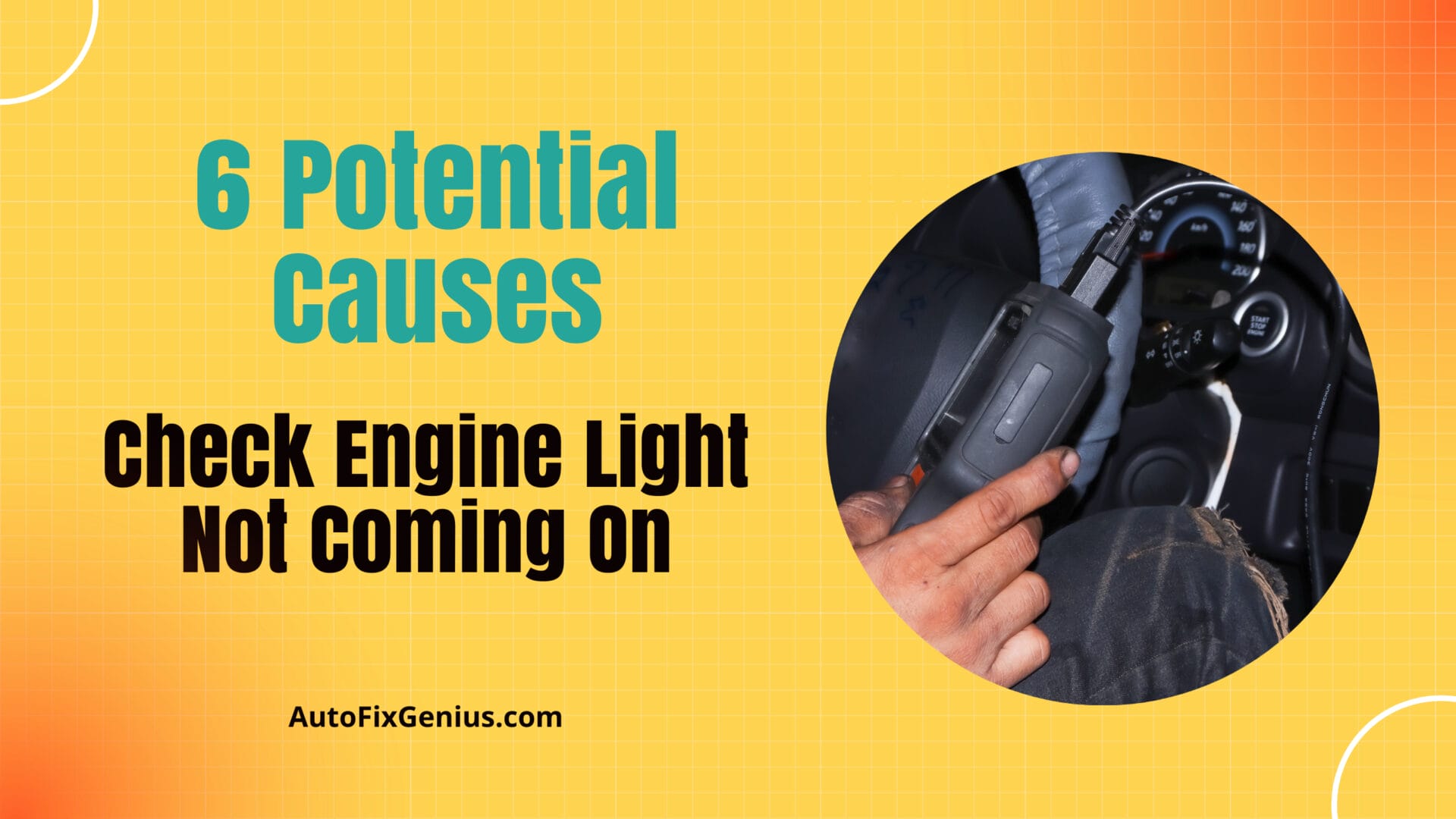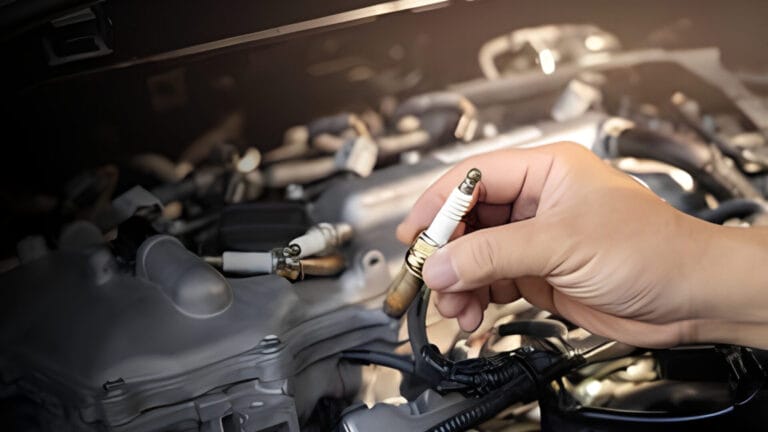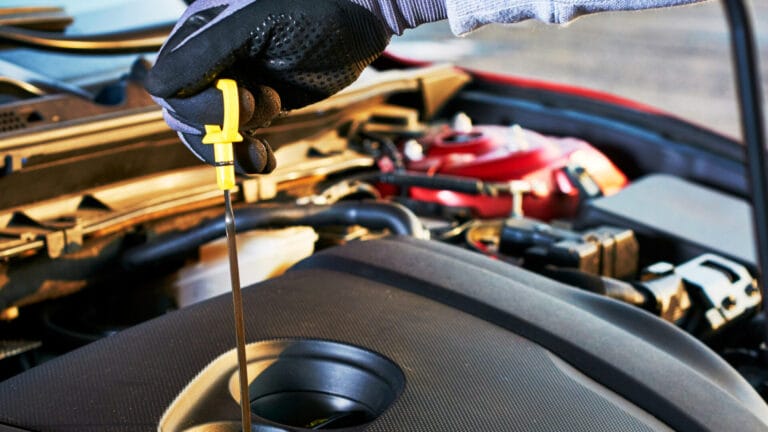Check Engine Light Not Coming On At All: Causes & Solutions Explored
Your check engine light should appear once you turn on your car or when your car’s computer detects a fault. Therefore, it’s wise to understand and address the absence of this warning light to maintain your car’s health.
So, what might explain your check engine light not coming on at all? Potential culprits are:
- Faulty check engine light bulb
- Wiring issues
- OBD II system malfunction
- Faulty sensor (e.g., crankshaft position, camshaft position, and oxygen sensor)
- Codes not stored
- Disabled check engine light
I’ll look deeper into the reasons for the no-check engine light when the key is in the ON position. Also, for each cause, I’ll give you a possible fix.
6 Potential Causes For Check Engine Light Not Coming On At All

This table gives a quick rundown of potential causes and fixes for a check engine light that doesn’t come on.
| NO. | Potential Cause | Solutions |
| 1 | Faulty CEL bulb | Replace the CEL bulb with the correct type |
| 2 | Wiring issues | Replace affected wiring sections |
| Tighten loose connections | ||
| 3 | OBD II system malfunction | Replace your PCM |
| 4 | Faulty sensor | Replace individual faulty sensors |
| 5 | Codes not stored | Check for recalls |
| Replace your PCM | ||
| 6 | Disabled check engine light | Let the dealership reprogram your PCM |
Now, I’ll get deeper into the potential causes, symptoms, and how-to solutions.
- Faulty Check Engine Light Bulb
One simple explanation is a burnt-out check engine light bulb. To know if the problem is really the bulb, perform a bulb check test. Here are the basic steps:
- Step 1: Turn on the ignition.
- Step 2: Touch the bulb terminals together, typically blue and black. The reason for this is to bypass the computer.
If, after these steps, the bulb doesn’t light, it’s likely blown. Alternatively, you can remove the CEL (check engine light) bulb from the socket and visually inspect it. Any cracks, blackening, or breaks in the filament mean the bulb is faulty.
The following may also indicate a faulty CEL bulb:
- Diagnostic trouble code present, but no CEL.
- The CEL bulb is older than the recommended replacement interval. Most need periodic replacement after 50,000 – 100,000 miles.
- Your check engine light bulb fails the bulb circuit test.
Watch the following video on how to do a bulb circuit test:
Solution
Replace the CEL bulb with a new one of the correct type. Ensure it lights briefly when you turn on the ignition.
Watch the following video on how to replace the check engine light.
- Wiring Issues
An electrical issue can prevent the CEL from working properly. One possibility is that the wiring harness is disrupting the circuit. Also, you may have a short circuit or open circuit on the wires leading to the CEL bulb.

Now, let me highlight a few things to check to help you determine if it’s a wiring issue:
- Check your wiring harness that connects to the PCM to rule out any corrosion, cuts, or loose connections.
- Set your multimeter to ohms and test the continuity between the PCM CEL signal wire and the bulb’s positive terminal. If you get near-zero resistance (0 to 0.2 ohms), the wire has no issues.
- Check continuity from your vehicle’s ground to the bulb’s negative terminal. Again, it should have near-zero resistance.
- Look for signs of damage along the wiring harness supplying the CEL circuit.
Solution
Replace the affected wiring sections completely. Alternatively, you can make a temporary fix while waiting for eventual repairs. For this, you’ll have to bypass the CEL circuit wiring and run a separate wire directly from the diagnostic port to the bulb.
Here’s how to bypass the CEL circuit wiring:
- Step 1: Locate the diagnostic port under the dash.
- Step 2: Use your multimeter to check for 12-volt power on the CEL signal wire pin location.
- Step 3: Disconnect the wiring harness from your CEL bulb socket.
- Step 4: Run a 22 AWG wire from the 12V CEL signal pin to the positive terminal of your bulb’s socket.
- Step 5: Ground the other end of the wire to a clean chassis ground point near the bulb.
You can now repair or replace your existing CEL wiring without losing CEL functionality.
- OBD II System Malfunction
The PCM commands the CEL. Therefore, if it fails, your check engine light won’t work. Here’s how you can tell your PCM has failed:
- There is no communication between your OBD II scanner and the computer.
- Erratic electrical behavior like abnormal operation of locks and gauges.
- You’ll get a flashing security light on some vehicles indicating the PCM is in “Limp Mode.”
- No response to resets or reprogramming.
Solution
Repairing a failed PCM isn’t practical. It can cause more engine issues sooner or later. So, if the wiring and codes point to the PCM as the root cause, PCM replacement is necessary. However, ensure it’s the correct type for your vehicle.
Watch the following how-to video for PCM replacement.
- Faulty Sensor
Your engine’s sensors are tied to the onboard computer and CEL. The primary examples are:
- Crankshaft position sensor
- Camshaft position sensor
- Oxygen sensor
- Mass airflow sensor
Typically, the PCM relies on sensor input to allow ignition and trigger CEL momentarily when you turn on the key. Here are signs that faulty sensors could be the problem:
- Erratic or out-of-range scanner readings.
- Diagnostic trouble codes related to individual sensors.
Solution
Potential fixes include:
- Checking for faulty wiring, loose connections, or corrosion at sensors.
- Test sensor circuits and components.
- Compare your sensor readings to specs during drive cycles with a scanner.
- Replace individual faulty sensors based on your conclusive diagnosis.
Watch the following video on how to test sensor circuits:
- Codes Not Stored
If the onboard computer is unable to store the corresponding DTCs, intermittent faults won’t trigger CEL. Essentially, most faults will fly under the radar.
Also, it could be that your system’s code memory has been wiped out recently. It can happen due to a scanner or battery disconnect. This means that the existing codes won’t power the ECM.
Here are symptoms that suggest DTCs are not stored properly in your OBD system:
- “No codes found” feedback on a code reader even when problems exist.
- Codes that were previously present clear themselves without repairs.
- Identical symptoms reappear, but codes aren’t detected on subsequent scans.
Solution
There are a few things you can check and try:
- Inspect and clean connectors leading to the PCM/ECM.
- Check for recalls related to your specific model having computer code storage problems.
- Clear existing codes from memory and road-test your car to try to reproduce the fault.
- Disconnect the battery for a few minutes to discharge the computer capacitors. Reconnect and retest.
If no codes are stored after all these, replace your PCM.
- Disabled Check Engine Light
Some vehicles allow you to temporarily disable the CEL through the instrumental panel menu. So, it’s possible you may have tampered with it accidentally.
Take the BMW models from the late 1990s to the mid-2000s, for instance. You can disable the CEL by pressing and holding the odometer rest and emergency flash buttons for 10 seconds. Nonetheless, these dashboard tricks are illegal and prevent the diagnosis of underlying problems.
Also, it’s possible that the CEL bulb was removed. It’s possible that your mechanic or dealer technician accidentally forgot to put back the bulb during a repair visit.
Solution
If the bulb is intact and working, disconnect your battery for 15 minutes to discharge the computer capacitors. Reconnect to see if the CEL turns back on.
If the CEL disable function is stored permanently, your last resort is to reprogram the PCM. Visit your dealership and have them reflash your PCM software with proprietary diagnostic tools.
FAQs
I’ll now highlight FAQs related to check engine light not coming on at all.
Is it safe to drive if the check engine light doesn’t come on?
It’s generally not advised since the CEL is an important fault indicator. Your vehicle won’t be able to flag emission-related faults and engine problems. Plus, it’s illegal in some states to drive with malfunctioning CEL.
Can a blown fuse cause the check engine light not to come on?
No. The check engine light doesn’t have its own dedicated fuse. Instead, it gets power directly from the ECM computer circuit.
Can I pass an emission test if my check engine light doesn’t come on?
No. An inoperable CEL means emission diagnostics can’t be fully run. So, it practically guarantees a test failure unless you resolve it first.
Conclusion
A check engine light not coming on at all can be concerning. Nonetheless, you can use my list of potential causes and fixes to take appropriate steps and restore functionality.
But if DIY solutions fail, consult a qualified mechanic. They have both the expertise and the proprietary diagnostic tools to pinpoint the problem.






